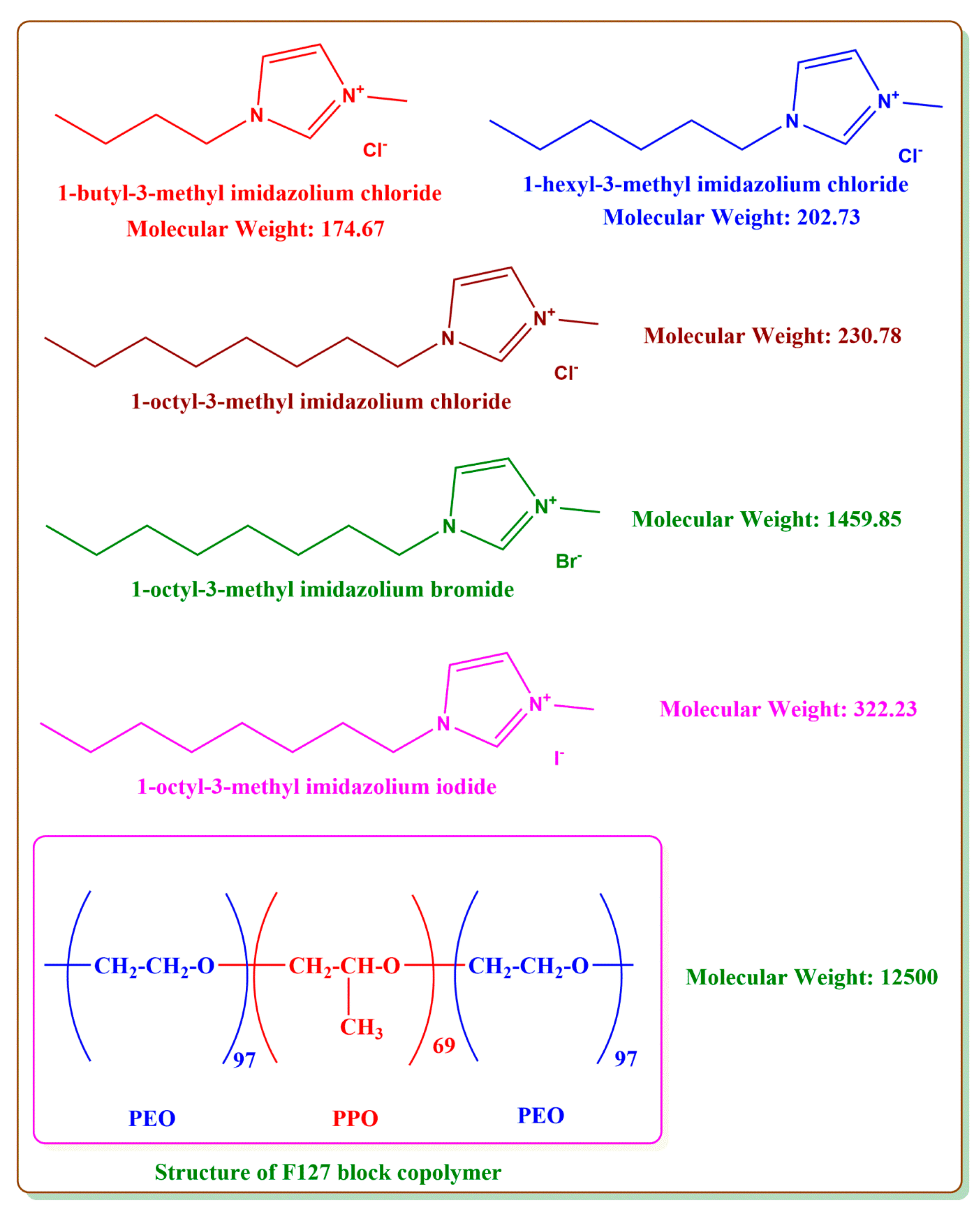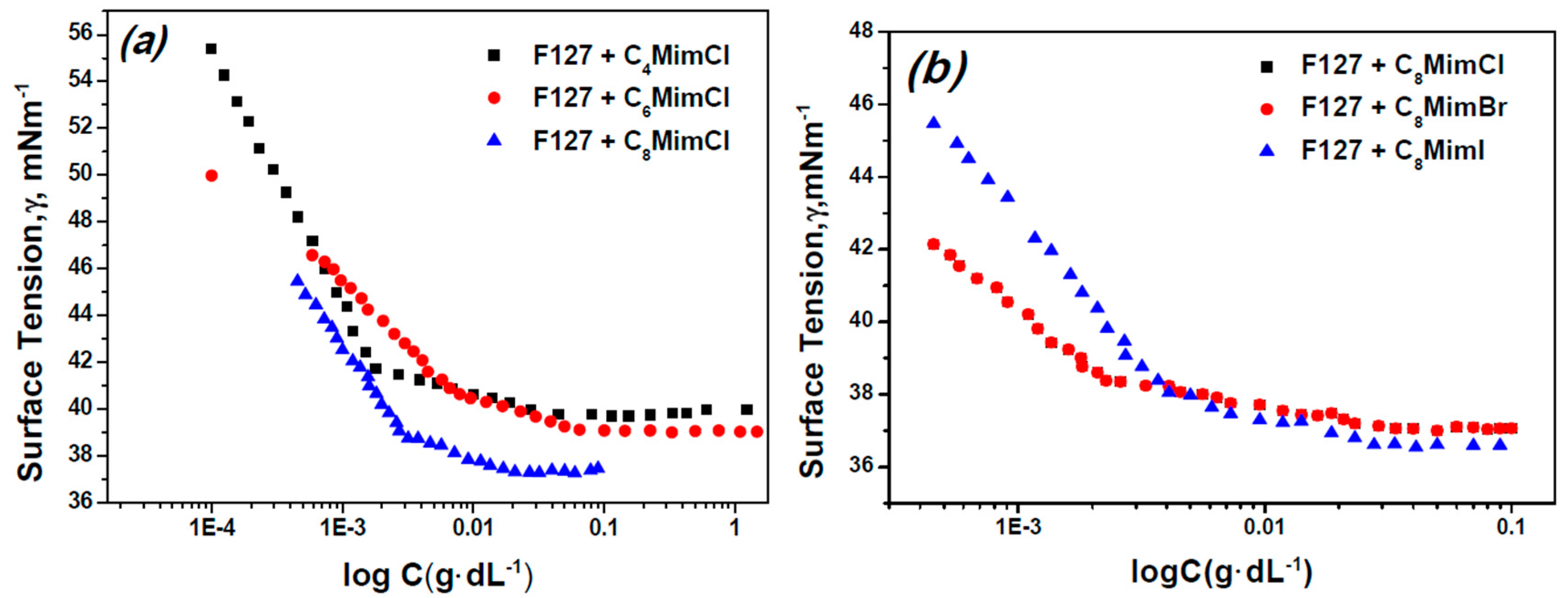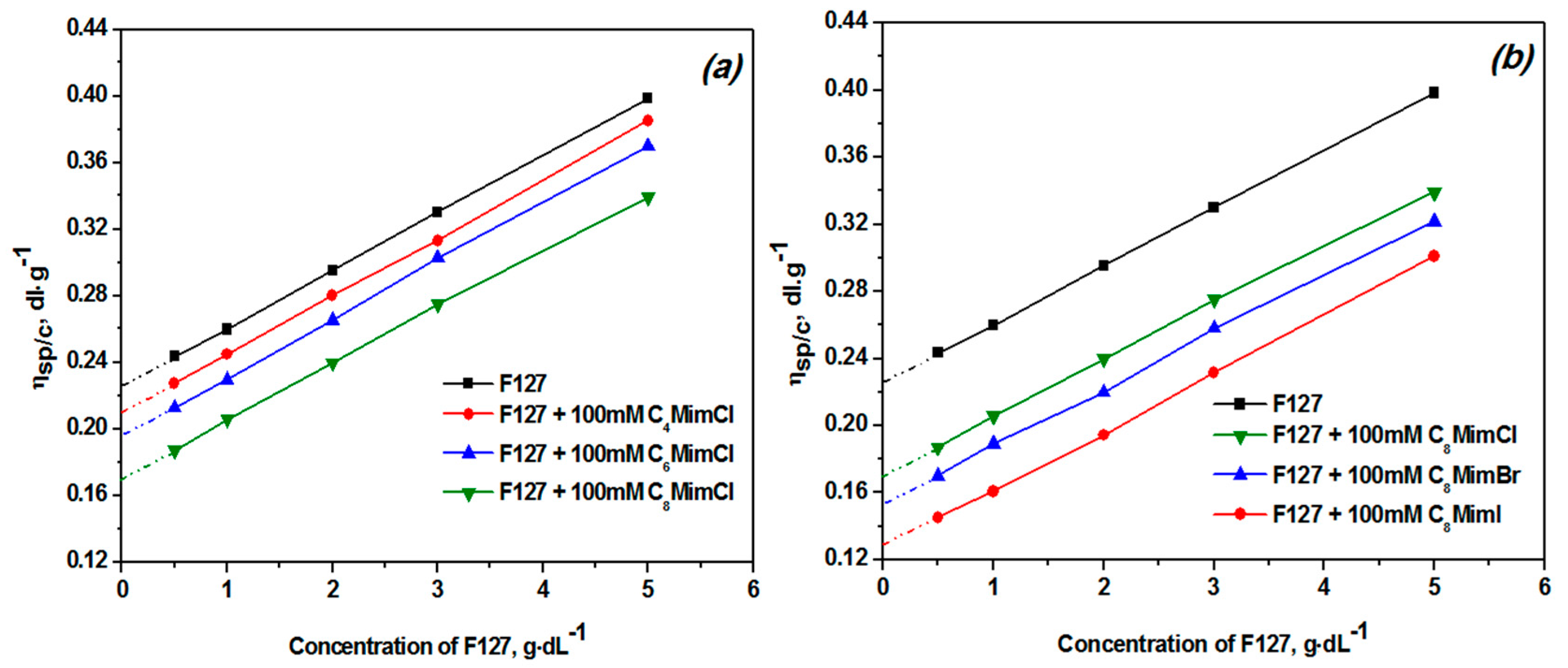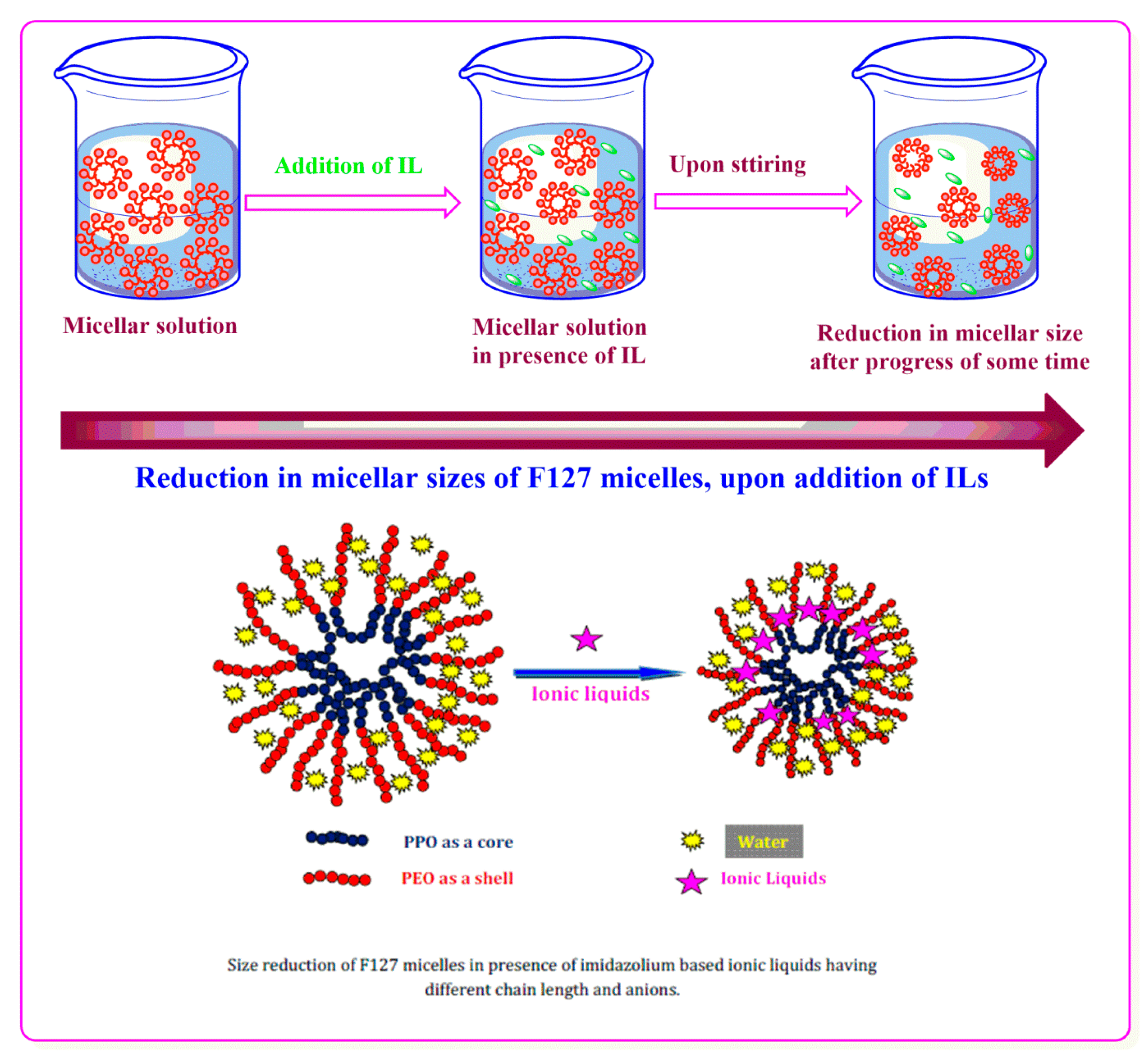Dependency of Anion and Chain Length of Imidazolium Based Ionic Liquid on Micellization of the Block Copolymer F127 in Aqueous Solution: An Experimental Deep Insight
Abstract
:1. Introduction
2. Materials and Methods
2.1. Dynamic Light Scattering (DLS)
Theoretical Approach for DLS Analysis
2.2. Surface Tension (ST)
2.3. Viscosity
3. Results and Discussion
3.1. Dynamic Light Scattering (DLS) Measurements
3.2. Surface Tension Measurements
3.3. Viscosity Measurements
4. Conclusions
Acknowledgments
Author Contributions
Conflicts of Interest
References
- Nakashima, K.; Bahadur, P. Aggregation of water-soluble block copolymers in aqueous solutions: Recent trends. Adv. Colloid Interface Sci. 2006, 123–126, 75–96. [Google Scholar] [CrossRef] [PubMed]
- Alexandridis, P.; Hatton, T.A. Poly(ethylene oxide)-poly(propylene oxide)-poly(ethylene oxide) block copolymer surfactants in aqueous solutions and at interfaces: Thermodynamics, structure, dynamics, and modelling. Colloids Surf. A 1995, 96, 1–46. [Google Scholar] [CrossRef]
- Kabanov, A.; Zhu, J.; Alakhov, V. Pluronic Block Copolymers for Gene Delivery. Adv. Genet. 2005, 53, 231–261. [Google Scholar] [PubMed]
- Kabanov, A.V.; Batrakova, E.V.; Alakhov, V.Y. Pluronic block copolymers for overcoming drug resistance in cancer. Adv. Drug Deliv. Rev. 2002, 54, 759–779. [Google Scholar] [CrossRef]
- Vekariya, R.L.; Dhar, A.; Lunagariya, J. Synthesis of Silver Nanoparticles in Aqueous Solution: Ionic Liquid Used as a Shape Transformer. Colloids Surf. Sci. 2016, 1, 1–5. [Google Scholar]
- Gibaud, A.; Grosso, D.; Smarsly, B.; Baptiste, A.; Bardeau, J.F.; Babonneau, F.; Doshi, D.A.; Chen, Z.; Brinker, C.J.; Sanchez, C. Evaporation-Controlled Self-Assembly of Silica Surfactant Mesophases. J. Phys. Chem. B 2003, 107, 6114–6118. [Google Scholar] [CrossRef]
- Hamley, I.W. Developements in Block Copolymer Science and Technology; John Wiley & Sons, Ltd.: Chichester, UK, 2004. [Google Scholar]
- Grillo, I.; Penfold, J.; Tucker, I.; Cousin, F. Spontaneous Formation of Nanovesicles in Mixtures of Nonionic and Dialkyl Chain Cationic Surfactants Studied by Surface Tension and SANS. Langmuir 2009, 25, 3932–3943. [Google Scholar] [CrossRef] [PubMed]
- Bakshi, M.S.; Singh, K. Synergistic interactions in the mixed micelles of cationic gemini with zwitterionic surfactants: Fluorescence and Krafft temperature studies. J. Colloid Interface Sci. 2005, 287, 288–297. [Google Scholar] [CrossRef] [PubMed]
- Rehman, N.; Khan, A.; Bibi, I.; Bica, C.I.D.; Siddiq, M. Intermolecular Interactions of Polymer/Surfactants Mixture in Aqueous Solution Investigated by Various Techniques. J. Dispers. Sci. Technol. 2013, 30, 1202–1210. [Google Scholar] [CrossRef]
- Khan, A.; Siddiq, M. Physicochemical Investigation of the Micellar Behavior of a Diblock (PEO)62-b-(PBO)33 Copolymer in Water and its Interaction with Ionic Surfactants. J. Dispers. Sci. Technol. 2016, 37, 519–529. [Google Scholar] [CrossRef]
- Ullah, F.; Khan, A.; Akil, H.; Siddiq, M. Effect of Hydrophilic/Hydrophobic Block Ratio and Temperature on the Surface and Associative Properties of Oxyethylene and Oxybutylene Diblock Copolymers in Aqueous Media. J. Dispers. Sci. Technol. 2015, 36, 1777–1785. [Google Scholar] [CrossRef]
- Jorgensen, E.B.; Hvidt, S.; Brown, W.; Schillen, K. Effects of Salts on the Micellization and Gelation of a Triblock Copolymer Studied by Rheology and Light Scattering. Macromolecules 1997, 30, 2355–2364. [Google Scholar] [CrossRef]
- Vekariya, R.L. Effects of cationic head groups of ionic liquid on micellization in aqueous solution of PEO-PPO-PEO triblock copolymer. J. Dispers. Sci. Technol. 2017, 38, 1594–1599. [Google Scholar] [CrossRef]
- Vekariya, R.L. Reduction of micellar size of PEO-PPO-PEO triblock copolymer in presence of ionic liquid in aqueous solutions: A SANS study. J. Dispers. Sci. Technol. 2017. [Google Scholar] [CrossRef]
- Frank, H.S.; Franks, F. Structural Approach to the Solvent Power of Water for Hydrocarbons; Urea as a Structure Breaker. J. Chem. Phys. 1968, 48, 4746–4757. [Google Scholar] [CrossRef]
- Cheng, Y.; Jolicoeur, C. Cosolvent Effects on Thermally-Induced Transitions of a Block Copolymer: Poly(ethylene oxide)-Poly(propylene oxide) in Aqueous Solutions. Macromolecules 1995, 28, 2665–2672. [Google Scholar] [CrossRef]
- Ohashi, K.; Hashizaki, K.; Taguchi, H.; Saito, Y. Effects of Inorganic Salts on Micellization and Solubilization in an Aqueous Solution of Poly(ethylene oxide)/Poly(propylene oxide)/Poly(ethylene oxide) Triblock Copolymer. J. Dispers. Sci. Technol. 2009, 30, 720–724. [Google Scholar] [CrossRef]
- Deyerle, B.A.; Zhang, Y. Effects of Hofmeister anions on the aggregation behavior of PEO-PPO-PEO triblock copolymers. Langmuir 2011, 27, 9203–9210. [Google Scholar] [CrossRef] [PubMed]
- Mata, J.; Joshi, T.; Varade, D.; Ghosh, G.; Bahadur, P. Aggregation behavior of a PEO-PPO-PEO block copolymer + ionic surfactants mixedsystems in water and aqueous salt solutions. Colloids Surf. A 2004, 274, 1–7. [Google Scholar] [CrossRef]
- Ma, J.; Guo, C.; Liu, H.; Wang, Y.; Tang, Y.; Bahadur, P. Oil-Induced Aggregation of Block Copolymer in Aqueous Solution. J. Phys. Chem. B 2007, 111, 11140–11148. [Google Scholar] [CrossRef] [PubMed]
- Armstrong, J.; Chowdhry, B.; Mitchell, J.; Beezer, A.; Leharne, S. Effect of Cosolvents and Cosolutes upon Aggregation Transitions in Aqueous Solutions of the Poloxamer F87 (Poloxamer P237): A High Sensitivity Differential Scanning Calorimetry Study. J. Phys. Chem. 1996, 100, 1738–1745. [Google Scholar] [CrossRef]
- Hsu, Y.; Tsui, H.; Lee, C.; Chen, S.; Chen, L. Effect of alcohols on the heat of micellization of Pluronic F88 aqueous solutions. Colloid Polym. Sci. 2015, 293, 3403–3415. [Google Scholar] [CrossRef]
- Vasilescu, M.; Bandula, R.; Lemmetyinen, H. Micropolarity and microviscosity of Pluronics L62 and L64 core–shell aggregates in water at various concentrations and additives examined by absorption and fluorescence probes. Colloid Polym. Sci., 2010, 288, 1173–1184. [Google Scholar] [CrossRef]
- Vekariya, R.L. A review of ionic liquids: Applications towards catalytic organic transformations. J. Mol. Liq. 2017, 227, 44–60. [Google Scholar] [CrossRef]
- Wassercheid, P.; Welton, T. Ionic Liquids in Synthesis, 2nd ed.; Wiley-VCH: Weinheim, Germany, 2007. [Google Scholar]
- Lunagariya, J.; Dhar, A.; Vekariya, R.L. Efficient esterification of n-butanol with acetic acid catalyzed by the Brönsted acidic ionic liquids: Influence of acidity. RSC Adv. 2017, 7, 5412–5420. [Google Scholar] [CrossRef]
- Vekariya, R.L.; Dhar, A.; Lunagariya, J. Synthesis and characterization of double –SO3H functionalized Brönsted acidic hydrogensulfate ionic liquid confined with silica through sol-gel method. Compos. Interfaces 2017, 24, 801–816. [Google Scholar] [CrossRef]
- Cornellas, A.; Perez, L.; Comelles, F.; Ribosa, I.; Manresa, A.; Garcia, M.T. Self-aggregation and antimicrobial activity of imidazolium and pyridinium based ionic liquids in aqueous solution. J. Colloid Interface Sci. 2011, 355, 164–171. [Google Scholar] [CrossRef] [PubMed]
- Zhang, X.; Peng, X.; Ge, L.; Yu, L.; Liu, Z.; Guo, R. Micellization behavior of the ionic liquid lauryl isoquinolinium bromide in aqueous solution. Colloid Polym. Sci. 2014, 292, 1111–1120. [Google Scholar] [CrossRef]
- Bandres, I.; Meler, S.; Giner, B.; Cea, P.; Lafuente, C. Aggregation Behavior of Pyridinium-Based Ionic Liquids in Aqueous Solution. J. Sol. Chem. 2009, 38, 1622–1634. [Google Scholar] [CrossRef]
- Jungnickel, C.; Luczak, J.; Ranke, J.; Fernandez, J.F.; Muller, A.; Thoming, J. Micelle formation of imidazolium ionic liquids in aqueous solution. Colloids Surf. A 2008, 316, 278–284. [Google Scholar] [CrossRef]
- Vekariya, R.L.; Kumar, N.S. Micellization behaviour of surface active N-alkyl pyridinium dodecylsulphate task-specific ionic liquids in aqueous solutions. Colloids Surf. A 2017, 529, 203–209. [Google Scholar] [CrossRef]
- Umapathi, R.; Venkatesu, P. Thermo-responsive triblock copolymer phase transition behaviour in imidazolium-based ionic liquids: Role of the effect of alkyl chain length of cations. J. Colloid Interface Sci. 2017, 485, 183–191. [Google Scholar] [CrossRef] [PubMed]
- Alexandridis, P.; Holzwarth, J.F. Differential Scanning Calorimetry Investigation of the Effect of Salts on Aqueous Solution Properties of an Amphiphilic Block Copolymer (Poloxamer). Langmuir 1997, 13, 6074–6082. [Google Scholar] [CrossRef]
- Bowers, J.; Butts, C.P.; Martin, P.J.; Vergara-Gutierrez, M.C.; Heenan, R.K. Aggregation Behavior of Aqueous Solutions of Ionic Liquids. Langmuir 2004, 20, 2191–2198. [Google Scholar] [CrossRef] [PubMed]
- Seddon, K.R.; Stark, A.; Torres, M. Influence of chloride, water, and organic solvents on the physical properties of ionic liquids. Pure Appl. Chem. 2000, 72, 2275–2287. [Google Scholar] [CrossRef]
- Pragatheeswaran, A.M.; Chen, S.B. Effect of Chain Length of PEO on the Gelation and Micellization of the Pluronic F127 Copolymer Aqueous System. Langmuir 2013, 29, 9694–9701. [Google Scholar] [CrossRef] [PubMed]
- Zhang, S.; Gao, Y.; Dong, B.; Zheng, L. Interaction between the added long-chain ionic liquid 1-dodecyl-3-methylimidazolium tetrafluoroborate and Triton X-100 in aqueous solutions. Colloids Surf. A 2010, 372, 182–189. [Google Scholar] [CrossRef]
- Wanka, G.; Hoffmann, H.; Ulbricht, W. Phase Diagrams and Aggregation Behavior of Poly(oxyethylene)-Poly(oxypropylene)-Poly(oxyethylene) Triblock Copolymers in Aqueous Solutions. Macromolecules 1994, 27, 4145–4159. [Google Scholar] [CrossRef]
- Jain, N.J.; George, A.; Contractor, K.; Bahadur, P. Salt induced micellization of ethylene oxide-propylene oxide block copolymers in aqueous solution. J. Surf. Sci. Technol. 1996, 12, 29–41. [Google Scholar]
- Chu, B.; Zhou, Z. Physical Chemistry of Polyalkylene Block copolymer Surfactants. In Nonionic Surfactants. Surf. Sci. Ser. 1996, 60, 67–144. [Google Scholar]
- Rosen, M.J. Surfactant and Interfacial Phenomena, 3rd ed.; John Wiley and Sons: New York, NY, USA, 1989; Chapters 2, 3 and 5. [Google Scholar]
- Desai, M.; Jain, N.J.; Sharma, R.; Bahadur, P. Temperature and Salt-Induced Micellization of Block copolymers in Aqueous Solution. J. Surfactants Deterg. 2000, 3, 193–199. [Google Scholar] [CrossRef]





| System | D0 × 108 cm2 s−1 | Rh (nm) | KD (Lit.mole−1) | R2 |
|---|---|---|---|---|
| F127 in water | 23.62 | 13.42 | 35.68 | 94.90 |
| 5% w/v F127 + C8MimCl | 32.1 | 9.03 | 3.10 | 98.57 |
| 5% w/v F127 + C4MimCl | 29.2 | 10.85 | 3.12 | 99.35 |
| 5% w/v F127 + C6MimCl | 29.7 | 10.67 | 3.51 | 98.41 |
| 5% w/v F127 + C8MimBr | 30.2 | 10.49 | 3.43 | 99.31 |
| 5% w/v F127 + C8MimI | 29.45 | 10.76 | 6.38 | 98.36 |
| System | CMC (g·dL−1) | γcmc (m·Nm−1) | ΔGmic (KJ/mol) |
|---|---|---|---|
| Pure F127 | 0.02950 | 41.12 | −19.00 |
| F127 + C4MimCl | 0.03400 | 37.74 | −18.65 |
| F127 + C6MimCl | 0.04300 | 38.06 | −18.05 |
| F127 + C8MimCl | 0.03668 | 37.05 | −18.65 |
| F127 + C8MimBr | 0.02100 | 37.31 | −19.01 |
| F127 + C8MimI | 0.03180 | 36.65 | −18.3 |
| Solution Systems | [η] (dL·g−1) | KH |
|---|---|---|
| F127 | 0.221 | 0.64 |
| F127 + C4MimCl | 0.201 | 0.75 |
| F127 + C6MimCl | 0.189 | 0.89 |
| F127 + C8MimCl | 0.165 | 1.10 |
| F127 + C8MimBr | 0.150 | 1.24 |
| F127 + C8MimI | 0.121 | 2.08 |
© 2017 by the authors. Licensee MDPI, Basel, Switzerland. This article is an open access article distributed under the terms and conditions of the Creative Commons Attribution (CC BY) license (http://creativecommons.org/licenses/by/4.0/).
Share and Cite
Lunagariya, J.; Kumar, N.S.; Asif, M.; Dhar, A.; Vekariya, R.L. Dependency of Anion and Chain Length of Imidazolium Based Ionic Liquid on Micellization of the Block Copolymer F127 in Aqueous Solution: An Experimental Deep Insight. Polymers 2017, 9, 285. https://doi.org/10.3390/polym9070285
Lunagariya J, Kumar NS, Asif M, Dhar A, Vekariya RL. Dependency of Anion and Chain Length of Imidazolium Based Ionic Liquid on Micellization of the Block Copolymer F127 in Aqueous Solution: An Experimental Deep Insight. Polymers. 2017; 9(7):285. https://doi.org/10.3390/polym9070285
Chicago/Turabian StyleLunagariya, Jignesh, Nadavala Siva Kumar, Mohammad Asif, Abhishek Dhar, and Rohit L. Vekariya. 2017. "Dependency of Anion and Chain Length of Imidazolium Based Ionic Liquid on Micellization of the Block Copolymer F127 in Aqueous Solution: An Experimental Deep Insight" Polymers 9, no. 7: 285. https://doi.org/10.3390/polym9070285







